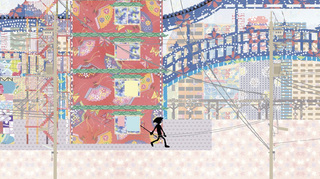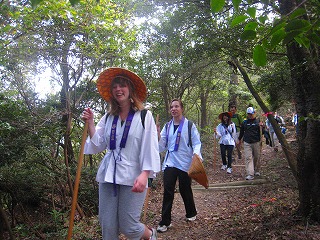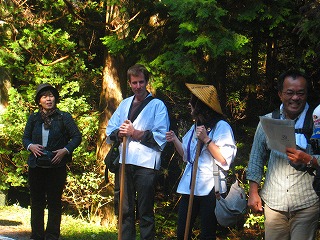HENRO
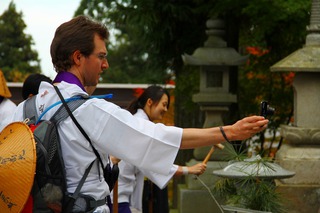
10 kilometers. Some up, some down. Some before, some after. A pilgrimage to just one of 88 temples. Forest, green and moss covered. Stones and statues, greening and mottled with liken.
"There is a temple further up and finally on top of this small Japanese mountain." I thought,
"Why?"
And then, the documentary voice in my head rattled on conversationally about the history and reasons for the creation of these sacred places. Sweat was dripping down my temple, and my clothing was damp despite the bout of cool weather in the air.
"Yes, yes I know all that!" said the pragmatist voice projecting from the apparent opposite side of my cranium.(Wherever that is.) "But, why!?"
I simply plodded on forward, I hadn't the energy to get involved with those two. There were legs to move and sweat to wipe, the occasional swig of water also needed attending to.
The pragmatist continued,"Really, the only thing up here, besides the odd, totally unattended tractor, and brand new, but entirely unused green house, is that temple."
"Plus, the power lines and the abandoned and forest reclaimed house. Not to mention that snake eating a frog we saw earlier." the documentary narrator spoke up again.
"Who wants to trek all the way up just for that?"
"And yet here we are, doing it."
But what these two idiots didn't realize was that they were sitting back enjoying the ride while I was doing all the hard work. Frankly, they were both getting quite annoying.
But, somewhere deep in the mists and fog of thought an answer was emerging, a quiet response of calm. Only my answer perhaps, but that was enough.
The trudging endlessly forward, one foot infront of the other, creaking joints aching muscles, the chilling air contrasted with the heat of exertion, and that beautiful blue sky glanced at every so often as a reprieve from this very simple, remarkably basic action. Walking.
The miracle is in the mundane.
I have two legs that move when I tell them to. Eyes that see. Hands that grasp. A chest that expands and contracts, and a heart that beats, always. Perhaps life is sacred, but that's not the point. It needs to be appreciated.
Next to all this, the temple is just an excuse. A reason for the journey, just to balance the books, to fill the gap after the word "because".
Now, there are bricks and mortar up there, incense burns and bells ring, but they just mark the post like check points in a racing circuit. They hide the secret, like a gigantic conspiracy, so accountants know where the money goes, and companies know where to put their vending machines.
"I am already here, before I left, when I arrive and when I go." That is the joke, monks smile about. The smirk of the secret they can't but help be written all over their faces.
When all is said and done, when civilizations start and end, when temples burn and mountains move.
People....will still walk. I guess the joke is on us then.
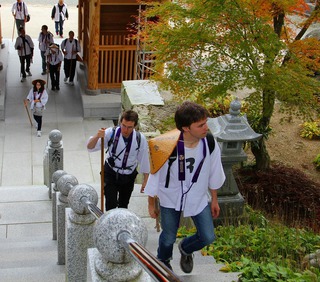
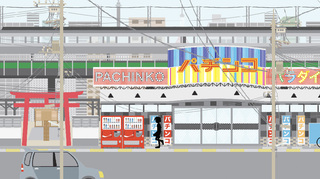
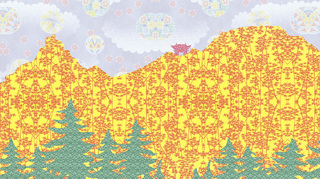 This particular submission was a response to how walking the pilgrimage can give you an appreciation of your environment. Walking along the rural path, amongst the trees and mountains reminds you of the natural environment we live it yet fail to recognize on a day to day basis. Japan is a country of contrasts where grey concrete cities are often located amongst mountain top temples and vast bamboo forests. After spending time within this beautiful environment, it's easy to return to our grey concrete homes with a sense of rejuvenation. Where once we saw square, boring buildings we behind to see hints of how Buddhist architecture and nature has influenced and informed modern day life in Japan.
This particular submission was a response to how walking the pilgrimage can give you an appreciation of your environment. Walking along the rural path, amongst the trees and mountains reminds you of the natural environment we live it yet fail to recognize on a day to day basis. Japan is a country of contrasts where grey concrete cities are often located amongst mountain top temples and vast bamboo forests. After spending time within this beautiful environment, it's easy to return to our grey concrete homes with a sense of rejuvenation. Where once we saw square, boring buildings we behind to see hints of how Buddhist architecture and nature has influenced and informed modern day life in Japan. 